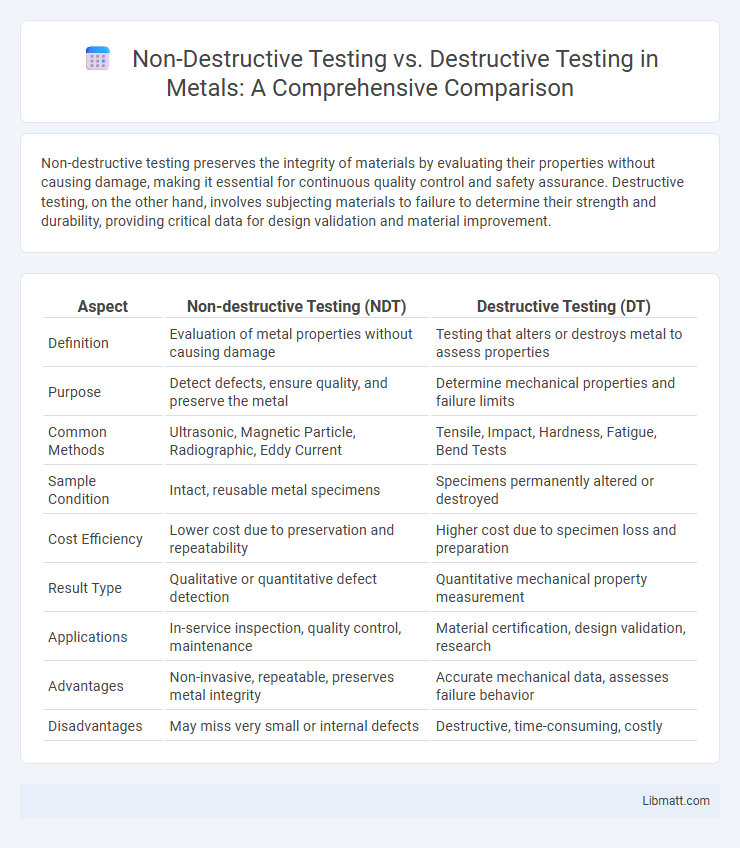Non-destructive testing preserves the integrity of materials by evaluating their properties without causing damage, making it essential for continuous quality control and safety assurance. Destructive testing, on the other hand, involves subjecting materials to failure to determine their strength and durability, providing critical data for design validation and material improvement.
Table of Comparison
| Aspect | Non-destructive Testing (NDT) | Destructive Testing (DT) |
|---|---|---|
| Definition | Evaluation of metal properties without causing damage | Testing that alters or destroys metal to assess properties |
| Purpose | Detect defects, ensure quality, and preserve the metal | Determine mechanical properties and failure limits |
| Common Methods | Ultrasonic, Magnetic Particle, Radiographic, Eddy Current | Tensile, Impact, Hardness, Fatigue, Bend Tests |
| Sample Condition | Intact, reusable metal specimens | Specimens permanently altered or destroyed |
| Cost Efficiency | Lower cost due to preservation and repeatability | Higher cost due to specimen loss and preparation |
| Result Type | Qualitative or quantitative defect detection | Quantitative mechanical property measurement |
| Applications | In-service inspection, quality control, maintenance | Material certification, design validation, research |
| Advantages | Non-invasive, repeatable, preserves metal integrity | Accurate mechanical data, assesses failure behavior |
| Disadvantages | May miss very small or internal defects | Destructive, time-consuming, costly |
Introduction to Material Testing Methods
Non-destructive testing (NDT) evaluates material integrity without causing damage, allowing for continued use of the tested component, whereas destructive testing involves testing materials to failure to assess mechanical properties like tensile strength, hardness, and impact resistance. NDT methods such as ultrasonic, radiographic, and magnetic particle testing provide crucial safety inspections in industries like aerospace and manufacturing, extending the lifecycle of parts. Destructive testing techniques, including tensile and bend tests, offer comprehensive data on material behavior under load, essential for material selection and quality assurance in engineering applications.
What is Non-Destructive Testing (NDT)?
Non-Destructive Testing (NDT) is a method used to evaluate the properties of a material, component, or system without causing damage. Techniques such as ultrasonic testing, radiographic testing, and magnetic particle inspection allow for defect detection and quality assessment while preserving the item's integrity. NDT plays a critical role in industries like aerospace, manufacturing, and construction by ensuring safety and reliability without compromising the tested object.
Understanding Destructive Testing (DT)
Destructive Testing (DT) involves subjecting materials or components to conditions that cause failure to evaluate their performance, strength, and durability. Common DT methods include tensile testing, impact testing, and hardness testing, which help identify the limits and weaknesses of a product. Unlike Non-destructive Testing (NDT), DT provides definitive data on material properties but results in the loss of the tested specimen.
Key Differences Between NDT and DT
Non-destructive testing (NDT) evaluates materials or components for defects without causing damage, preserving their usability, while destructive testing (DT) involves physically altering or destroying samples to determine properties like strength or failure points. NDT methods include ultrasonic, radiographic, and magnetic particle testing, offering real-time assessments and cost efficiency by maintaining part integrity. In contrast, DT procedures such as tensile, impact, and hardness tests provide more definitive data on material behavior under stress but require sample sacrifice and are unsuitable for final product inspection.
Advantages of Non-Destructive Testing
Non-destructive testing (NDT) preserves the integrity of materials and components while providing accurate evaluation, enabling repeated inspections without causing damage. It enhances safety by detecting flaws early and reducing downtime, leading to cost-effective maintenance and prolonged asset lifespan. NDT techniques such as ultrasonic, radiographic, and magnetic particle testing offer precise defect characterization without compromising operational efficiency.
Benefits and Limitations of Destructive Testing
Destructive Testing provides accurate and detailed insights into a material's mechanical properties by deliberately breaking or altering the sample, ensuring reliability in critical applications such as aerospace or construction. However, its limitations include irreversibility, higher costs due to sample destruction, and the inability to test finished products or in-service components without causing damage. Understanding these trade-offs helps you choose the appropriate testing method based on your quality assurance and safety requirements.
Common Techniques Used in NDT
Common techniques used in Non-Destructive Testing (NDT) include ultrasonic testing, radiographic testing, magnetic particle testing, liquid penetrant testing, and eddy current testing. Ultrasonic testing utilizes high-frequency sound waves to detect internal flaws, while radiographic testing employs X-rays or gamma rays for imaging internal structures. Magnetic particle and liquid penetrant testing are primarily used for surface defect detection, with eddy current testing focusing on surface and near-surface flaw identification in conductive materials.
Typical Applications for Destructive Testing
Destructive testing is commonly applied in industries such as aerospace, automotive, and construction to evaluate material strength, fracture toughness, and fatigue limits by intentionally damaging samples. This method ensures safety and compliance by revealing failure modes, critical defects, and performance thresholds under extreme conditions. Your engineering team can rely on destructive testing to validate designs and optimize materials for maximum durability.
Selecting the Right Testing Method for Your Project
Selecting the right testing method depends on project requirements, including material type, inspection goals, and budget constraints. Non-destructive testing (NDT) techniques like ultrasonic, radiographic, and magnetic particle testing preserve the integrity of materials, making them ideal for quality control and in-service inspections. Destructive testing (DT) methods, such as tensile, hardness, and impact testing, provide detailed mechanical property data but consume the sample, often used for prototype validation or failure analysis.
Future Trends in Material Testing Technologies
Future trends in material testing technologies emphasize the advancement of Non-destructive Testing (NDT) methods, such as ultrasonic phased array inspection and digital radiography, which provide faster and more accurate assessments without damaging the tested materials. Destructive Testing (DT) continues to evolve with enhanced simulation and automation to reduce sample usage while improving data precision. Your choice of testing method will increasingly depend on integrating AI-driven analytics and IoT-enabled sensors to achieve real-time, predictive maintenance and quality control in various industries.
Non-destructive Testing vs Destructive Testing Infographic

 libmatt.com
libmatt.com